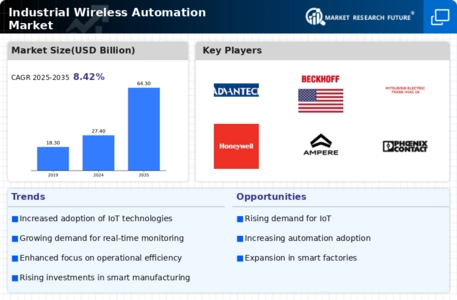Market Growth Projections
The Global Industrial Wireless Automation Market Industry is poised for substantial growth, with projections indicating a market size of 64.3 USD Billion by 2035. This growth trajectory reflects the increasing adoption of wireless automation technologies across various sectors, driven by factors such as technological advancements and the need for operational efficiency. The market is expected to experience a CAGR of 8.07% from 2025 to 2035, highlighting the sustained interest in wireless solutions. As industries continue to embrace digital transformation, the demand for innovative automation technologies is likely to rise, further solidifying the market's expansion.
Rising Demand for Automation
The Global Industrial Wireless Automation Market Industry experiences a surge in demand for automation solutions across various sectors. Industries are increasingly adopting wireless automation technologies to enhance operational efficiency and reduce costs. For instance, the manufacturing sector is projected to reach a market value of 27.4 USD Billion in 2024, driven by the need for real-time monitoring and control systems. This trend indicates a shift towards more agile production processes, enabling companies to respond swiftly to market changes. As organizations seek to optimize their operations, the integration of wireless technologies becomes pivotal in achieving these objectives.
Growing Adoption of IoT in Industries
The growing adoption of IoT technologies is a key driver in the Global Industrial Wireless Automation Market Industry. Industries are increasingly leveraging IoT to enhance connectivity and data analytics capabilities. This integration allows for real-time monitoring and control of industrial processes, leading to improved efficiency and productivity. For example, IoT-enabled devices can provide valuable insights into equipment performance and maintenance needs, reducing downtime and operational costs. As the IoT ecosystem continues to expand, its impact on wireless automation is expected to be profound, contributing to a projected CAGR of 8.07% from 2025 to 2035.
Increased Focus on Safety and Compliance
The Global Industrial Wireless Automation Market Industry is witnessing an increased focus on safety and compliance regulations. Industries are prioritizing the implementation of wireless automation solutions to enhance workplace safety and meet regulatory requirements. For instance, wireless sensors and monitoring systems can detect hazardous conditions in real-time, allowing for prompt responses to potential risks. This focus on safety not only protects employees but also minimizes operational disruptions. As companies strive to adhere to stringent safety standards, the adoption of wireless automation technologies is expected to rise, contributing to the overall growth of the market.
Cost Efficiency and Operational Flexibility
Cost efficiency and operational flexibility are driving factors in the Global Industrial Wireless Automation Market Industry. Organizations are increasingly recognizing the financial benefits of adopting wireless automation solutions, which can lead to significant cost savings in terms of installation and maintenance. Wireless systems eliminate the need for extensive wiring, reducing both upfront and ongoing expenses. Moreover, these systems provide greater flexibility in operations, allowing companies to adapt to changing production needs without major disruptions. As businesses seek to optimize their resources, the demand for cost-effective wireless automation solutions is likely to grow, further propelling market expansion.
Technological Advancements in Wireless Communication
Technological advancements in wireless communication play a crucial role in shaping the Global Industrial Wireless Automation Market Industry. Innovations such as 5G and IoT are revolutionizing industrial processes by providing faster and more reliable connectivity. These technologies facilitate seamless data exchange between devices, leading to improved decision-making and operational efficiency. For example, the implementation of 5G networks is expected to enhance the performance of industrial automation systems significantly. As these advancements continue to evolve, they are likely to drive market growth, with projections indicating a market size of 64.3 USD Billion by 2035.












